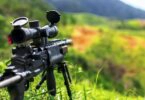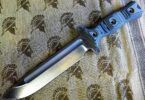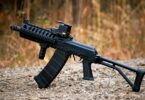Combat knives are designed for hand-to-hand combat, but over the years, they have begun also to be used for other utility purposes like survival. Each type of knife has its specific use, and today, we’ll talk about combat, tactical, and fighting knives.
The terms combat, tactical, and fighting seem distinct, but they are often interchangeable. For example, combat and fighting knives are the same but use two different words to describe them.
A combat/fighting knife is used primarily for attacking or defending, while a tactical knife has other uses.
See also: Self Defense Knives: How to Choose The Best Blade for Your Safety.
Table of contents
Tactical knives can be used as flashlights, whistles, holding compartments, etc. It’s unlikely that you’d bring these knives to war, but they are still helpful in dangerous situations.
Many survivalists consider the best combat knives to combine tactical ability with close-combat features. As a result, these combat knives will excel as survival weapons and tools in times of need.
What to Consider When Choosing a Combat Knife
Choosing the knife that works for you is often a matter of personal preference what how you plan to use the knife. There are a few other things you should consider before making your choice.
- Design – A combat knife is designed for just that, combat. These knifes are intended for mortally wounding or killing an opponent. Choose the knife you are mos comfortable using – stabbing, slashing, etc.
- Laws – Different states, town, and municipalities have different laws surrounding what you can and cannot carry. The American Kife and Tools Institute (AKTI) provides a good resource to research your state’s and cities laws before making a decision.
- Use or Utility – Do you want a knife that can both be used in combat and in a survival situation?
- Knife Handle – You definitely want a handle that won’t let you down in a life or death fight. Wood and synthetic materials are the most common handle types. The handle should also fit your hand and have a good grip. Covering the grip with rubber, or even thread or wire, make it easier to grip in tight, fast situations.
- Blade – If you strictly buying a knife for combat, consider a straight edge blade. It won’t snag and cuts quickly and efficiently. Blade quality, lenght and construction are also important when carrying a knife. How you carry the knife? What you use it for (serrated blades for survival uses)? These are all important considerations.
Different Types of Combat Knifes
There are several types of combat knives to consider. As I mentioned earlier, some of these are strictly for fighting, and others have multiple uses.
- Utility (Tactical) Knives – These knives have multiple uses. Handles are used as storage compartments for matches, tinder, a compass,fishing gear, etc., and some even have serrated edges that are intended to be used as saws.
- Fixed Blade – These knives are not as easily concealed as a folding knife, and are carried in a sheath. These are some of the most popular combat knives – Ka-Bars, Karambits, etc.
- Folding Knives – Folding knives are often used as a utility knife because they are easy to conceal and tuck away for when they are needed. They are also more of a defensive type of knife, used for slashing types of maneuvers where you want to stop your enemy and not necessarily kill them.
Combat Knife Recommendations
There are hundreds of knife choices. Below are the knives that I like, based on quality, effectiveness, and utility.
SOG Seal Pup Elite Tactical Fixed Blade
Stainless Steel, 4.75-inch blade, 9.5 x 1.55 x 0.7 inches, full-tang, 5.4 ounces, hard-molded Kydex sheath, black, titanium-nitrate coated blade.
- Price
- Quality
- Balance
- Sheath Comfort
- Handle Grooves
- Knife fit
The SOG Seal Pup combat knife is one of the best mass-manufactured knives that you will find at this price point.
Let me also get this out of the way. Although this is a SOG, it is not made in the US. Many of their products are produced in Taiwan. I prefer products made in the US, but I also understand the current cost of domestic manufacturing.
If you want a good quality knife made here in the United States at a reasonable price point, check out Ka-bar knives. I’ll mention these more later in this post.
WHAT I LIKE: You are getting a quality knife that is just about indestructible for this price. The 4.75-inch blade on the 9-inch knife is a good versatile size, and at 5 ounces, this knife is well balanced and quick to use.
This is a full-tang knife with a nitrate-coated, heat-treated blade and glass-reinforced, grooved handle grip that is as tough as they get. You are not going to easily damage this knife.
OPPORTUNITIES: The hard, molded sheath is not my favorite. It is not very comfortable to wear and does not attach easily to my other gear. But, then again, I change just about all of my sheaths.
KA-BAR BKR7-BRK Combat Utility
D2 Steel, 7-inch blade, 11-7/8" length, 12.8 ounces, glass-filled nylon sheath, 20-degree blade, Kraton-G handle.
- Well-balanced knife for fighting
- Well-made
- Durable D2 Steel
- Sheath shipped sometimes Kydex
This is a Ka-Bar, so there are not very many cons. This is a perfect combat knife that can also serve as a solid utility knife when needed.
The D2 steel is very sharp and stays sharp, but it is not meant for chopping, so remember that when it’s time to split firewood.
You really can’t go wrong with this Ka-Bar, whether in a hand-to-hand fight for your life on in the backcountry.
WHAT I LIKE: This is a very well-balanced, well-made knife that feels good in your hand. The knife is made for combat first, and you will appreciate the easy-to-grip Grafton G material on the handle.
OPPORTUNITIES: The sheath some people receive appears to be a toss-up – nylon or Kydex. The preferred sheath or the one that most customers prefer is the nylon sheath.
GERBER StrongArm Fixed Blade Knife
High Carbon Steel, 4.8-inch blade, 16 inches long, 14.1 ounces, modular sheath, rubberized diamond texture grip, full tang, ceramic blade coating.
- Rust-resistant steel (420)
- Interchangeable for combat and bushcraft
- Versatile modular sheath
- Not always sharp out of the box
- Hard to lay flat on belt
Gerber is another US company that makes quality products. I still use the first pocket knife I ever purchased in 1996, and after hard use it still looks like I just purchased it, so yeah, I’m a Gerber fan.
You are getting a quality knife for $75 bucks, and although it is a good combat knife, it it also be used as a solid utility knife in bushcraft.
WHAT I LIKE: I like the versatility of this knife. This is definitely a combat knife, but it also the knife I carry when going into the backcountry. The knife is well-made, and although there is harder steel, I like the moisture resistant 420 steel. I also like the modular sheath, which allows you carry the knife in multiple positions.
OPPORTUNITIES: I like the sheath but there is some question about the durability that time will tell. It is not thick plastic like Kydex, and there is only one point for clipping, but the versatility of the design more than makes up for this.
Final Thoughts
Combat knives shouldn’t just be killing machines; they should also have a tactical advantage. Look for a specialty combat knife to expand your survival arsenal with multiple uses.
If you need to move fast, you don’t want to carry multiple weapons and tools. Choose a knife that serves several purposes.
The best combat knife will be durable, multipurpose, and easily transported. Combat knives may be pricey, but they are worth the cost in dangerous situations. You’ll be glad that you made this purchase in a SHTF scenario.









What can I say, the MTECH USA XTREME MX-8054 knife is perfect in shape, size and design. I have an excellent collection, and this is the most outstanding addition. I didn’t get to use it so much, but from my experience, it is a great knife. Everything about it is made for me, the sheath, the blade, the handle itself is made with ergonomics heavily on the mind.
Hi Bobby, we are glad we could help.
I think high-quality steel can literally make or break a knife. For me, choosing a knife with the appropriate steel for the job is the key to picking a tactical knife.
Nowadays, knife makers are using a wider range of steel alloys more than any time before, so it’s crucial to learn about the different types of steel that will fit your purpose.
In a survival (non-combat) situation, any knife is better than no knife. However, the best combat knives tend to be less optimal for survival, and the best survival knives tend to be less optimal for combat.
In particular, the “dagger” blade can be very good for combat with the appropriate training, but is very poor for most survival tasks.
Peter,
Thank you for your comment. Yes, the make of the steel is what makes the knife, a knife. The best quality steel should be resistant to vibration and does not dull easily. Researchers are currently trying out different metal combinations to further improve steel as we know it.
David
Resistant to vibration? I would say the best steel for knives would be one with a fine grain structure which supports a very sharp edge, and a formulation which accepts sharpening easily yet strongly resists dulling. Not brittle enough to chip or shatter, and flexible enough to bend without breaking. Corrosion resistance would be nice, although often this conflicts with the more desirable properties.
Hi John!
You are correct with your observations. I myself keep two kinds of knives handy; one for combat and one for general use. I can use both of them as weapons but I prefer that I have one that I can use for other tasks. I can actually defend with the general purpose knife while I parry with the combat knife.
It does take a while to get used to two knives and which one goes to which side of the body but it was the perfect set-up once I got the hang of it.
Regards,
David
Thank you John for your input. I do agree with your point about knives having a fine grain structure. What I meant with vibration is that minute vibrations cause by relative action against the flat side of the blade can sometimes affect the integrity. It is just something I have observed and nothing scientific though.
David
Combat knives have been proven to be types of survival weapons needed by everyone to repel an aggressor and stay safe. There are the combat, tactical, and fighting knives. These weapons have passed quality tests and have the Navy SEALs. Some of these knives are SOG fixation bowie fixed blade FX01, cold steel micro recon 1 tanto tactical folder, Szco supplies M-9 Bayonet, etc. What other defensive mechanisms could be used to fight the attacker in the absence of these knives?
You should not make the mistake of confusing a kitchen/regular knife with a combat knife. What differentiates the two are: design, purpose, ergonomics, size, materials, handle, blade design, fixed/folder, and carry options. This posting provides you with the best combat knives with respect to the above-mentioned factors.